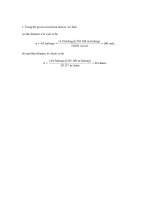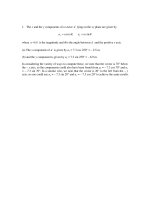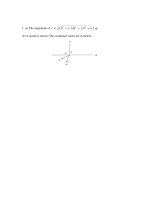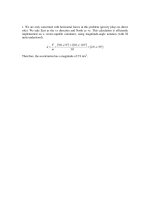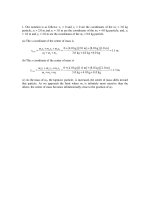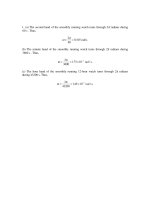Solution manual fundamentals of physics extended, 8th editionch24
Bạn đang xem bản rút gọn của tài liệu. Xem và tải ngay bản đầy đủ của tài liệu tại đây (1.51 MB, 124 trang )
1. (a) An Ampere is a Coulomb per second, so
FG
H
84 A ⋅ h = 84
C⋅h
s
IJ FG 3600 s IJ = 3.0 × 10
K H hK
5
C.
(b) The change in potential energy is ∆U = q∆V = (3.0 × 105 C)(12 V) = 3.6 × 106 J.
2. The magnitude is ∆U = e∆V = 1.2 × 109 eV = 1.2 GeV.
3. The electric field produced by an infinite sheet of charge has magnitude E = σ/2ε0,
where σ is the surface charge density. The field is normal to the sheet and is uniform.
Place the origin of a coordinate system at the sheet and take the x axis to be parallel to the
field and positive in the direction of the field. Then the electric potential is
V = Vs −
z
x
0
E dx = Vs − Ex ,
where Vs is the potential at the sheet. The equipotential surfaces are surfaces of constant x;
that is, they are planes that are parallel to the plane of charge. If two surfaces are
separated by ∆x then their potentials differ in magnitude by ∆V = E∆x = (σ/2ε0)∆x. Thus,
∆x =
2ε 0 ∆ V
σ
=
c
hb g = 8.8 × 10
2 8.85 × 10−12 C 2 N ⋅ m2 50 V
−6
. × 10 C m
010
2
−3
m.
4. (a) VB – VA = ∆U/q = –W/(–e) = – (3.94 × 10–19 J)/(–1.60 × 10–19 C) = 2.46 V.
(b) VC – VA = VB – VA = 2.46 V.
(c) VC – VB = 0 (Since C and B are on the same equipotential line).
c
. × 10 Ch = 2.4 × 10 N C .
h c160
. mg = 2.9 × 10 V.
(b) ∆V = E∆s = c2.4 × 10 N Chb012
5. (a) E = F e = 3.9 × 10−15 N
4
−19
4
3
6. (a) By Eq. 24-18, the change in potential is the negative of the “area” under the curve.
Thus, using the area-of-a-triangle formula, we have
V − 10 = −
x =2
z
0
G G 1
E ⋅ ds = 2 20
2
b gb g
which yields V = 30 V.
G G
(b) For any region within 0 < x < 3 m,− E ⋅ ds is positive, but for any region for which
z
x > 3 m it is negative. Therefore, V = Vmax occurs at x = 3 m.
V − 10 = −
z
x =3
0
G G 1
E ⋅ ds = 3 20
2
b gb g
which yields Vmax = 40 V.
(c) In view of our result in part (b), we see that now (to find V = 0) we are looking for
some X > 3 m such that the “area” from x = 3 m to x = X is 40 V. Using the formula for a
triangle (3 < x < 4) and a rectangle (4 < x < X), we require
1
1 20 + X − 4 20 = 40 .
2
b gb g b
Therefore, X = 5.5 m.
gb g
7. (a) The work done by the electric field is (in SI units)
W =³
i
f
G G qσ
q0 E ⋅ ds = 0
2ε 0
³
d
0
q0σ d (1.60 ×10−19 )(5.80 ×10−12 )(0.0356)
=
= 1.87 ×10−21 J.
dz =
−12
2ε 0
2(8.85 ×10 )
(b) Since V – V0 = –W/q0 = –σz/2ε0, with V0 set to be zero on the sheet, the electric
potential at P is (in SI units)
σz
(5.80 ×10−12 )(0.0356)
V =−
=−
= −1.17 ×10−2 V.
−12
2ε 0
2(8.85 ×10 )
8. We connect A to the origin with a line along the y axis, along which there is no change
G G
of potential (Eq. 24-18: E ⋅ ds = 0 ). Then, we connect the origin to B with a line along
z
the x axis, along which the change in potential is
∆V = −
z
x =4
0
which yields VB – VA = –32.0 V.
G G
E ⋅ ds = −4.00
z
4
0
FG 4 IJ
H 2K
2
x dx = −4.00
9. (a) The potential as a function of r is (in SI units)
V ( r ) = V ( 0 ) − ³ E ( r )dr = 0 − ³
=−
r
r
0
0
qr
qr 2
dr
=
−
4πε 0 R 3
8πε 0 R 3
(8.99 ×109 )(3.50 ×10−15 )(0.0145) 2
= −2.68 ×10−4 V.
2(0.0231)3
(b) Since ∆V = V(0) – V(R) = q/8πε0R, we have (in SI units)
(8.99 ×109 )(3.50 ×10−15 )
V ( R) = −
=−
= −6.81×10−4 V.
8πε 0 R
2(0.0231)
q
10. The charge is
q = 4πε 0 RV =
(10m) (−1.0V)
8.99 ×10 N ⋅ m
9
2
/C
2
= −1.1×10−9 C.
11. (a) The charge on the sphere is
q = 4 πε 0 VR =
(200 V)(0.15 m)
= 3.3 × 10 −9 C.
2
N
m
⋅
8.99 × 10 9
C2
(b) The (uniform) surface charge density (charge divided by the area of the sphere) is
σ=
q
3.3 × 10 −9 C
=
= 12
. × 10 −8 C / m 2 .
2
4 πR 2 4 π 015
. m
b
g
12. (a) The potential difference is
VA − VB =
q
4πε 0 rA
−
q
4πε 0 rB
= (1.0 ×10
−6
2
§
1
1 ·
9 N⋅m · §
C ) ¨ 8.99 ×10
−
¸ ¨
¸
2
C ¹ © 2.0 m 1.0 m ¹
©
= −4.5 ×103 V.
G
(b) Since V(r) depends only on the magnitude of r , the result is unchanged.
13. First, we observe that V (x) cannot be equal to zero for x > d. In fact V (x) is always
negative for x > d. Now we consider the two remaining regions on the x axis: x < 0 and
0 < x < d.
(a) For 0 < x < d we have d1 = x and d2 = d – x. Let
V ( x) = k
FG q
Hd
1
+
1
IJ
K
q2
q
=
4 πε 0
d2
FG 1 + −3 IJ = 0
H x d − xK
and solve: x = d/4. With d = 24.0 cm, we have x = 6.00 cm.
(b) Similarly, for x < 0 the separation between q1 and a point on the x axis whose
coordinate is x is given by d1 = –x; while the corresponding separation for q2 is d2 = d – x.
We set
V ( x) = k
FG q
Hd
1
1
+
IJ
K
q2
q
=
4 πε 0
d2
FG 1 + −3 IJ = 0
H −x d − xK
to obtain x = –d/2. With d = 24.0 cm, we have x = –12.0 cm.
14. Since according to the problem statement there is a point in between the two charges
on the x axis where the net electric field is zero, the fields at that point due to q1 and q2
must be directed opposite to each other. This means that q1 and q2 must have the same
sign (i.e., either both are positive or both negative). Thus, the potentials due to either of
them must be of the same sign. Therefore, the net electric potential cannot possibly be
zero anywhere except at infinity.
15. A charge –5q is a distance 2d from P, a charge –5q is a distance d from P, and two
charges +5q are each a distance d from P, so the electric potential at P is (in SI units)
V=
q
(8.99 ×109 )(5.00 ×10−15 )
ª 1 1 1 1º
−
−
+
+
=
=
= 5.62 ×10−4 V.
4πε 0 «¬ 2d d d d »¼ 8πε 0 d
2(4.00 ×10−2 )
q
The zero of the electric potential was taken to be at infinity.
16. In applying Eq. 24-27, we are assuming V → 0 as r → ∞. All corner particles are
equidistant from the center, and since their total charge is
2q1– 3q1+ 2 q1– q1 = 0,
then their contribution to Eq. 24-27 vanishes. The net potential is due, then, to the two
+4q2 particles, each of which is a distance of a/2 from the center. In SI units, it is
V=
4q2
1 4q2 16q2 16(8.99 ×109 )(6.00 ×10−12 )
+
=
=
= 2.21 V.
4πε 0 a / 2 4πε 0 a / 2 4πε 0 a
0.39
1
17. (a) The electric potential V at the surface of the drop, the charge q on the drop, and
the radius R of the drop are related by V = q/4πε0R. Thus
c
hc
h
8.99 × 10 9 N ⋅ m 2 / C 2 30 × 10 −12 C
q
R=
=
= 5.4 × 10 −4 m.
4 πε 0V
500 V
(b) After the drops combine the total volume is twice the volume of an original drop, so
the radius R' of the combined drop is given by (R')3 = 2R3 and R' = 21/3R. The charge is
twice the charge of original drop: q' = 2q. Thus,
V′ =
1 q′
1
2q
=
= 2 2 / 3V = 2 2 / 3 (500 V) ≈ 790 V.
4 πε 0 R ′ 4 πε 0 2 1/ 3 R
18. When the charge q2 is infinitely far away, the potential at the origin is due only to the
charge q1 :
V1 =
q1
4πε 0 d
= 5.76 × 10−7 V.
Thus, q1/d = 6.41 × 10−17 C/m. Next, we note that when q2 is located at x = 0.080 m, the
net potential vanishes (V1 + V2 = 0). Therefore,
0=
kq2
kq
+ 1
0.08 m d
Thus, we find q2 = −(q1 / d )(0.08 m) = –5.13 × 10−18 C = –32 e.
19. We use Eq. 24-20:
8.99 × 109
1 p
V=
=
4 πε 0 r 2
e
N⋅m2
C2
. × 3.34 × 10
j c147
c52.0 × 10 mh
−9
2
−30
h
C⋅m
. × 10−5 V.
= 163
20. From Eq. 24-30 and Eq. 24-14, we have (for θi = 0º)
p cos θi·
§p cos θ
Wa = q∆V = e ¨
¸=
2 −
4πεo r2 ¹
©4πεo r
ep
(cos θ − 1) .
4πεo r2
where r = 20 × 10−9 m. For θ = 180º the graph indicates Wa = −4.0 × 10−30 J, from which
we can determine p. The magnitude of the dipole moment is therefore 5.6 × 10−37 C.m.
21. (a) From Eq. 24-35, in SI units,
ª L / 2 + ( L2 / 4) + d 2 º
λ
ln «
»
4πε 0
d
«¬
»¼
ª (0.06 / 2) + (0.06) 2 / 4 + (0.08) 2
−12
9
= 2(8.99 ×10 )(3.68 ×10 ) ln «
0.08
«¬
= 2.43 ×10−2 V.
V =2
(b) The potential at P is V = 0 due to superposition.
º
»
»¼
22. The potential is (in SI units)
1
VP =
4πε 0
dq
1
−Q
(8.99 ×109 )(25.6 ×10−12 )
= −6.20 V.
³ rod R = 4πε 0 R ³ rod dq = 4πε 0 R = −
3.71×10−2
We note that the result is exactly what one would expect for a point-charge –Q at a
distance R. This “coincidence” is due, in part, to the fact that V is a scalar quantity.
23. (a) All the charge is the same distance R from C, so the electric potential at C is (in SI
units)
V=
5Q1
1 ª Q1 6Q1 º
5(8.99 ×109 )(4.20 ×10−12 )
−
=
−
=
−
= −2.30 V,
4πε 0 «¬ R
R »¼
4πε 0 R
8.20 ×10−2
where the zero was taken to be at infinity.
(b) All the charge is the same distance from P. That distance is
potential at P is (in SI units)
V=
R 2 + D 2 , so the electric
Q1
6Q1 º
5Q1
1 ª
−
« 2
»=−
2
2
2
2
4πε 0 ¬ R + D
R +D ¼
4πε 0 R 2 + D
=−
5(8.99 ×109 )(4.20 ×10−12 )
(8.20 × 10−2 ) 2 + (6.71×10−2 ) 2
= −1.78 V.
24. Since the charge distribution on the arc is equidistant from the point where V is
evaluated, its contribution is identical to that of a point charge at that distance. We
assume V → 0 as r → ∞ and apply Eq. 24-27:
V=
=
1 +Q1
1 +4Q1
1 −2Q1
1 Q1
+
+
=
4πε 0 R 4πε ο 2 R 4πε 0 R
4πε 0 R
(8.99 ×109 )(7.21×10−12 )
= 3.24 ×10−2 V.
2.00
25. The disk is uniformly charged. This means that when the full disk is present each
quadrant contributes equally to the electric potential at P, so the potential at P due to a
single quadrant is one-fourth the potential due to the entire disk. First find an expression
for the potential at P due to the entire disk. We consider a ring of charge with radius r and
(infinitesimal) width dr. Its area is 2πr dr and it contains charge dq = 2πσr dr. All the
charge in it is a distance r 2 + D 2 from P, so the potential it produces at P is
dV =
1 2πσ rdr
σ rdr
.
=
2
2
4πε 0 r + D
2ε 0 r 2 + D 2
The total potential at P is
V=
σ
2ε 0
³
R
0
rdr
r 2 + D2
=
σ
r 2 + D2
2ε 0
R
0
=
σ ª 2
R + D2 − Dº .
¼
2ε 0 ¬
The potential Vsq at P due to a single quadrant is (in SI units)
Vsq =
V σ ª 2
(7.73 ×10−15 ) ª
R + D2 − Dº =
(0.640) 2 + (0.259) 2 − 0.259 º
=
−12 ¬
¬
¼
¼
4 8ε 0
8(8.85 ×10 )
= 4.71×10−5 V.
